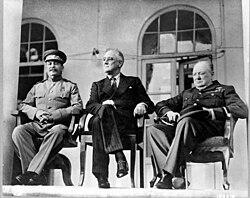Foreign policy of the United States
The foreign policy of the United States is the way that the United States acts towards other countries and involves setting out how US organizations, corporations, and individual citizens should act towards foreign countries.[1][2]
The US has a lot of power in the world for several reasons. The country has a $15 trillion economy and approximately a quarter of the global gross domestic product. It also has a defense budget of $711 billion, which is about 43% of military spending in the world. The US has a powerful military, which it can send out to protect countries or locations that are considered important to the country's foreign policy.[3]
The US Secretary of State does the same as the foreign minister of other countries and is responsible for diplomacy with other countries. The position is now held by Antony Blinken. However, the President of the United States has the highest authority over US foreign policy.
The United States House Committee on Foreign Affairs aims to control nuclear technology and nuclear hardware, foster commercial relations with foreign nations, and safeguard US business abroad. The committee also watches over international agreements about commodities, international education, and the protection of American citizens abroad.
US foreign policy includes defining what actions and choices are in the best national interest and the strategies that are chosen to lead to the country's policy goals. Those goals are to create a more secure, democratic, and prosperous world. The US aims to achieve that goal for the benefit of its people and of the international community.
US foreign policy and foreign aid have been the subject of much debate, praise and criticism from both within the US and in other countries.
Foreign Policy Of The United States Media
The Jay Treaty of 1795 aligned the U.S. more with Britain and less with France, leading to political polarization at home.
President Richard Nixon went to China to open friendly relations and meet Chinese Communist Party Chairman Mao Zedong in 1972.
President Donald Trump and his Western allies from G7 and NATO
A U.S. soldier stands guard duty near a burning oil well in the Rumaila oil field, Iraq, April 2003.
Defense treaty allies of the United States
A map of allies of the United States* NATO member states, including their colonies and overseas possessions* Major non-NATO allies* Signatories of Partnership for Peace with NATO
References
- ↑ "Background of American Foreign Policy". www.cliffsnotes.com. Retrieved 2021-06-21.
- ↑ "Foreign Policy: What Now? [ushistory.org]". www.ushistory.org. Retrieved 2021-06-21.
- ↑ Lindsay, Ivo H. Daalder and James M. (2003-01-01). "The Globalization of Politics: American Foreign Policy for a New Century". Brookings. Retrieved 2021-06-21.








